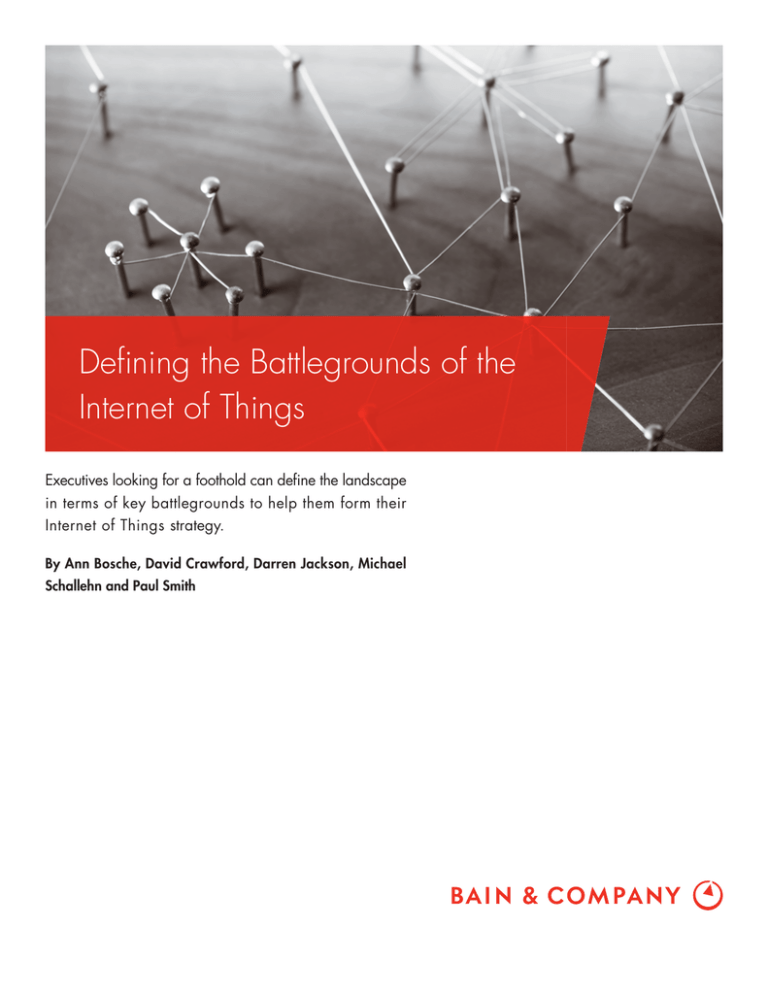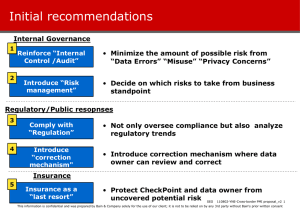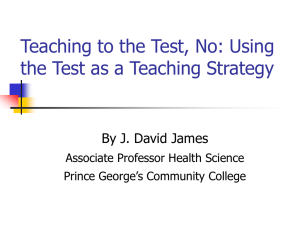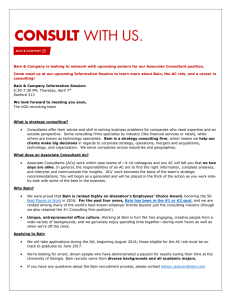
Defining the Battlegrounds of the
Internet of Things
Executives looking for a foothold can define the landscape
in terms of key battlegrounds to help them form their
Internet of Things strategy.
By Ann Bosche, David Crawford, Darren Jackson, Michael
Schallehn and Paul Smith
Ann Bosche is a partner with Bain & Company in San Francisco and Darren
Jackson is a partner in Bain’s Los Angeles office. David Crawford, Michael
Schallehn and Paul Smith are partners with Bain in Silicon Valley. All work
with Bain’s Global Technology, Media and Telecommunications practice. David
leads the Technology practice in the Americas, and Paul leads Bain’s Telecommunications practice globally.
The authors would like to acknowledge the contributions of Radhika Josyula,
a manager in Bain’s Silicon Valley office.
Copyright © 2016 Bain & Company, Inc. All rights reserved.
Defining the Battlegrounds of the Internet of Things
will help companies determine where to invest and
what capabilities are required to win.
The Internet of Things—a huge network of sensors
and smart devices, combined with advanced analytics and cloud services to make sense of all the
data—promises to augment and disrupt products
and services across industries. Expectations grow
more spectacular every day: Forecasters predict up to
20 billion1 Internet of Things devices within a few
years, generating 5 trillion2 gigabytes of data every
year and creating more than $300 billion in opportunities for tech vendors, telcos and device makers
by 2020.
Emerging battlegrounds
When we look across consumer, enterprise, industrial and public sectors, we see a few major battlegrounds emerging, each with unique platform dynamics and growth opportunities.
•
Consumer. As leading mobile platform providers
(Apple, Google and Samsung) extend their reach
into wearables, smart homes, cars and other aspects
of consumers’ lives, many software and hardware makers will find their place in these ecosystems. Successful players will invest in learning
which platforms offer the best opportunities,
depending on their region, target market and
capabilities. Expect fierce competition among
this small set of platform providers, using scale,
developer communities, device partnerships
and businesses subsidized by data. Creating
platform stickiness and bridging customers
across industry segments will be the keys to success.
•
Enterprise and industrial. As industrial and enterprise equipment and devices get connected, incumbents focused on specific industries are building
on their domain expertise and customer relationships by expanding into broader offerings.
Many will form partnerships, either to improve
their capabilities (especially in analytics and security) or to acquire expertise in adjacent industries. Those that can build scale and make partnerships work can shape platform standards. Given
the diversity of industries, expect a wide range
of vendor platforms that may share common
features but are tailored for particular uses.
•
Network and gateway. Connecting devices
through the network provides opportunities for
new products and services. Edge analytics and
real-time (or low-latency) services will become
increasingly important, close to sources of data
Feeling overwhelmed yet? You’re not alone.
Executives across industries know they need to understand where the Internet of Things will affect their
industry, where value comes from in their industry,
where their companies can enter and play, and what
capabilities they need to win. But many tell us they
are finding it difficult to get a foothold and develop
a strategy. Many are already investing significantly,
but few have a clear roadmap. Customers are very
interested, but complete solutions are still in
their infancy.
The Internet of Things is not one market
but a set of overlapping markets with
strong connections to the data center
and analytics.
Before technology executives can form their strategies, they need to see that the Internet of Things is
not one market but a set of overlapping markets
with strong connections to the data center and analytics. Understanding where battlegrounds are
emerging, how platform dynamics will shape competition and profitability, and what barriers exist to
adoption (for example, security and interoperability)
1
Defining the Battlegrounds of the Internet of Things
Figure 1: The Internet of Things is not a single market but a collection of overlapping ecosystems
Apps and services
Consumer
Cloud and
analytics
Analytics
Network,
directory
and gateway
Network and gateway
Enterprise and industrial
Autonomous
Things
Consumer
Personal
(wearables,
AR/VR)
Enterprise and industrial
Transportation
(logistics,
rail, drones)
Automotive
(infotainment,
automated driving)
Home
(smart TV,
appliances, security)
Healthcare
(remote patient
monitoring, hospital)
Retail
(point of sale,
digital signage)
Financial services
(banking,
insurance)
Building
(office and
building automation)
Industrial
(smart factories,
and worksites)
Infrastructure
(parking, traffic
management,
smart grid)
To get a better understanding of the different ecosystems at play in the Internet of Things, we analyzed potential products
and services across 10 industry sectors and through the technology stack, from hardware and communications on up to
applications and services. We also considered the current or likely participants in each vertical and horizontal use case
and where their efforts would reach up or down the stack or across verticals. Our findings yield a map of the battlegrounds
where players will vie to participate within the dominant ecosystems of the emerging Internet of Things—a dynamic
representation that is sure to evolve with the technologies and markets represented.
Note: AR/VR=augmented reality/virtual reality
Source: Bain & Company
2
Defining the Battlegrounds of the Internet of Things
rather than in the data center. Examples include
patient monitoring in hospitals, quality control
in factories and better customer experiences in
stores. Therefore, many businesses will look to
their long-standing relationships with network
equipment makers (such as Cisco, Ericsson,
Huawei and Nokia) and telecom service providers
to capitalize on the opportunities. Telcos will
aim to capitalize on the proliferation of devices
and apps in several ways. They will improve connections with better directory services to locate,
authenticate and connect remote devices. And
they will offer life-cycle management services to
maintain, upgrade, secure and provision the
complex device and sensor networks—which
others will compete to offer, too.
•
•
on board, with less (though not zero) connectivity
back to the cloud, creating different demands on
local vs. remote data storage and processing
than other Internet of Things applications. Startups and incumbents are moving quickly to get in
on the ground floor where current industry leadership and capabilities matter less than in other areas.
For example, cars have long been sold on the driving
experience, but that may be less important than
reliability and safety for selling autonomous cars.
Real-time capabilities and technologies such as
computer vision and machine learning will be important differentiators for success.
Robotics, drones and autonomous driving
are among the most greenfield of all
these applications, and an area where
current industry leadership and capabilities matter less than in others.
Analytics. Analytics will emerge as a critical
platform battleground, given their importance
for creating value from Internet of Things data.
Traditional analytics vendors (for example, IBM,
SAP and Microsoft), cloud service providers
(such as Amazon Web Services and Alibaba) and
system integrators could successfully extend
their customer relationships and scale into tailored
products and services, especially in instances in
which Internet of Things data is critical but only
one of many data sources contributing to insights and decisions. By contrast, new pure play
vendors will offer custom analytic solutions in
which limited integration with broader data
sources is needed. For both horizontal and pure
play vendors, partnerships with industry incumbents will be important—for example, IBM’s
work with Medtronic on diabetes management,
Amazon Web Services’ work with John Deere in
agriculture or SAP’s partnership with Siemens
on smart manufacturing solutions.
A company’s position and the dynamics in each battleground provide guardrails for an Internet of Things
strategy. Executives can design their strategy by considering a few questions.
Autonomous. Robotics, drones and autonomous
driving are among the most greenfield of all
these applications. They differ in that most sensor
information is collected locally and processed
3
•
What segments should we prioritize? Where can
we generate revenue and profits?
•
What do our customers need? Who will we compete
against, and how can we differentiate ourselves?
•
What parts of a solution should we deliver on
our own, and where will we need partners? What
standards should we support?
•
What capabilities will we need? Where should
we invest?
•
What are the risks of not acting?
Defining the Battlegrounds of the Internet of Things
Answering these questions to form a strategy in the
context of the Internet of Things battlegrounds will
be critical for executives to position their companies
for leadership. Mobilizing now is essential as the Internet of Things gains traction and begins to influence most
industries over the next three to five years.
This is the first in a planned series of Bain briefs providing
our perspective on the Internet of Things.
1
Gartner Forecast Analysis: Internet of Things—Endpoints, Worldwide, 2015 Update
2 IDC: The Digital Universe of Opportunities: Rich Data and the Increasing Value of the Internet of Things, April 2014
4
Shared Ambit ion, True Results
Bain & Company is the management consulting firm that the world’s business leaders come
to when they want results.
Bain advises clients on strategy, operations, technology, organization, private equity and mergers and acquisitions.
We develop practical, customized insights that clients act on and transfer skills that make change stick. Founded
in 1973, Bain has 53 offices in 34 countries, and our deep expertise and client roster cross every industry and
economic sector. Our clients have outperformed the stock market 4 to 1.
What sets us apart
We believe a consulting firm should be more than an adviser. So we put ourselves in our clients’ shoes, selling
outcomes, not projects. We align our incentives with our clients’ by linking our fees to their results and collaborate
to unlock the full potential of their business. Our Results Delivery® process builds our clients’ capabilities, and
our True North values mean we do the right thing for our clients, people and communities—always.
Key contacts in Bain & Company’s Telecommunications, Media & Technology practice
Americas:
Herbert Blum in Toronto (herbert.blum@bain.com)
Ann Bosche in San Francisco (ann.bosche@bain.com)
Mark Brinda in New York (mark.brinda@bain.com)
David Crawford in Silicon Valley (david.crawford@bain.com)
Darren Jackson in Los Angeles (darren.jackson@bain.com)
Mark Kovac in Dallas (mark.kovac@bain.com)
Michael Schallehn in Silicon Valley (michael.schallehn@bain.com)
Velu Sinha in Silicon Valley (velu.sinha@bain.com)
Paul Smith in Silicon Valley (paul.smith@bain.com)
Asia-Pacific:
Prashanth Aluru in Bangalore (prashanth.aluru@bain.com)
Bumshik Hong in Seoul (bumshik.hong@bain.com)
Florian Hoppe in Singapore (florian.hoppe@bain.com)
Hyukjin Lee in Seoul (hyukjin.lee@bain.com)
Steven Lu in Shanghai (steven.lu@bain.com)
Arpan Sheth in Mumbai (arpan.sheth@bain.com)
Bhanu Singh in New Delhi (bhanu.singh@bain.com)
Europe,
Middle East
and Africa:
Hans-Joachim Heider in Munich (hans-joachim.heider@bain.com)
François Montaville in Paris (francois.montaville@bain.com)
Michael Schertler in Munich (michael.schertler@bain.com)
Christopher Schorling in Frankfurt (christopher.schorling@bain.com)
For more information, visit www.bain.com









